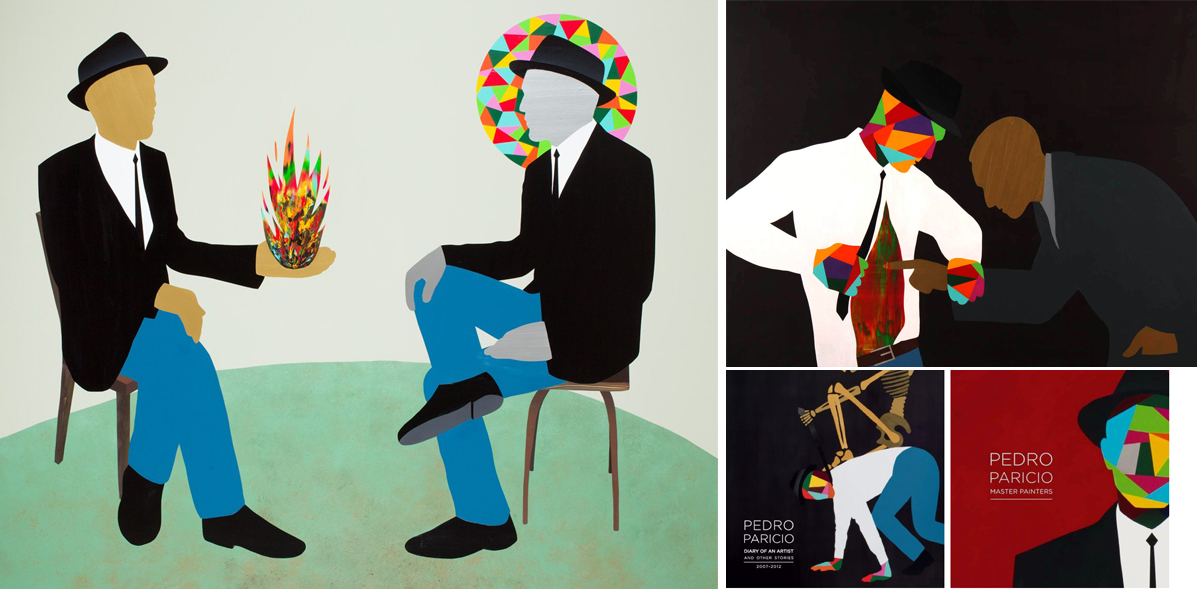Suited and booted, the artist Pedro Paricio looks like he’s come straight out of a scene from Reservoir Dogs. Born in 1982 in Tenerife in the Canary Islands, he is young, talented and now successful too. After working dozens of different jobs in pursuit of realising his dream of painting, he now lives off his art. And he lives well, at that.
He was signed up by the prestigious Halcyon Gallery in 2011 and it couldn’t have gone better for both parties. Diary of an Artist and Other Stories 2007-2012 was the artist’s second exhibition in this gallery. There were more than 50 exhibits with price tags ranging from £25,000, right up to £120,000. Almost all of them sold; some of them to important institutions.
Paricio’s artwork is first and foremost about contrasts of colour. Contrary to many other artists, his evolution has led him from the abstract towards a tendency for the figurative. He doesn’t play around with perception or with shadows, we find ourselves faced with a geometric and flat universe with constant nods to the 20th century painters he most admires. The artworks of his idols are sometimes the inspiration behind entire series, as was the case with Francis Bacon.
Before arriving in London, some Spanish galleries had already given him the opportunity to exhibit. The Ikara Gallery in Barcelona hosted his The Canary Paradise project in 2008, whilst Galería Muro in Valencia displayed the exhibition Un pintor. Otro. and Fe infinita were also shown in the Galería Fidel Balaguer in Barcelona. In addition, there was the significant exhibition in Seville’s magnificent Casino de la exposición, entitled The Theatre of Painting, where Juan Manuel Bonet praised his artwork and international career.

We put some questions to Pedro:
Every artist reveals a bit of himself in his artwork. In your case, self-portraits are incredibly important, especially in your most recent series. Is this some sort of internal search? Are self-portraits the most intimate creative exercise? Tell us something about that. Self-portraits allow me to reflect in two directions, I can speak about myself but at the same time about everyone else, because we are all different and yet we are all the same. You and I are we: two sides of the same coin. It’s also a question which touches on honesty and personal truth both of which are fundamental when it comes to art: without truth there is no work of art. My self-portrait is now my truth.
The first thing you see when you go on your website is a fantastic video which talks to us about colour, both in the world and in your artwork. Colour and great contrasts are clearly the building blocks of your artwork. Has it always been that way? Was it the landscapes of the Canary Islands that brought this on? The light of the Canary Islands has shaped who I am and the way I see the world, without a shadow of a doubt. This vision has then filtered into the different places where I’ve lived: Salamanca, Barcelona, London, Seville, Ibiza, etc. But it all goes back to the motherland, the Canary Islands, there’s no doubt about that. Tenerife is an incredible and, up to a point, surreal place, in its landscapes, the mixture of cultures and its island character. It’s no accident that the first international surrealist exhibition outside of France took place in Tenerife, with André Breton at the fore.
Your career took a leap forward when the Halcyon Gallery in London signed you up a few years ago. Do you think that the UK offered you opportunities where Spain didn’t? What do you think about the art market in both countries? Spain did offer me opportunities, my work was shown in many great galleries such as the Galería Muro in Valencia and the Galería Balaguer in Barcelona and significant media outlets such as La Vanguardia, El Mundo, Televisión Española and Tendencias del Mercado del Arte mentioned my work. I don’t think that you can compare different realities and anyway, I’m no expert in economics, what I can be sure of is that on a creative level, there is no country which Spain should feel jealous of, we are a land full of artists and this makes me very happy.

What is your relationship with the Halcyon Gallery like? Do you work with them exclusively? What steps did you take to secure representation from such a renowned international gallery? It’s great. It’s so gratifying that a gallery with three sites in London and another in Shanghai, which sells the works of masters such as Picasso and Matisse, would put such complete trust in a 29-year-old painter. Since I started working with them, I have been able to dedicate myself entirely to painting. The steps to success? Paint, paint, paint as if your life depended on it, because it works for me, because it’s what I am… because without painting I am nothing.
What are your dreams and plans for the future? Paint, study and live, which is one and the same thing.
When did you realise that you were an artist? Never, it’s not something that you realise, it’s something you are or you are not.
What do you think is your role in the current world of art? The same as Jack Nicholson’s in ‘One Flew Over the Cuckoo’s Nest’.
Who’s inspiring you to create at the moment? Wong Kar-wai, Fyodor Dstoyevsky and Tia Anica, la Piriñaca
What is your favourite food? A good bottle of red wine and anything that goes with it.
[su_note note_color=”#eaeae9″]Translated by Ben Ffrancon Davies[/su_note]
